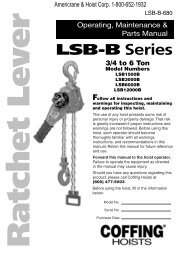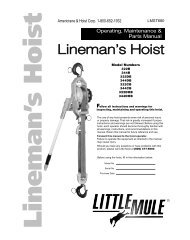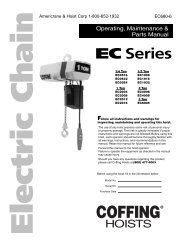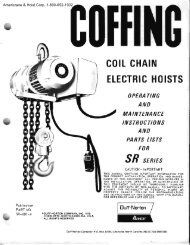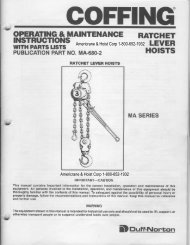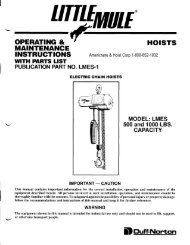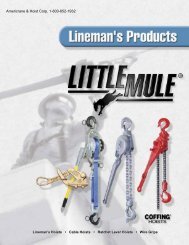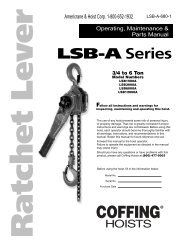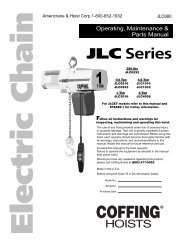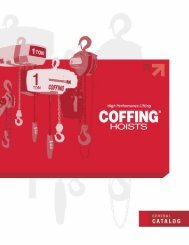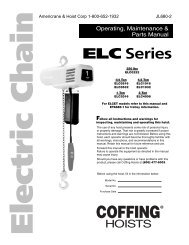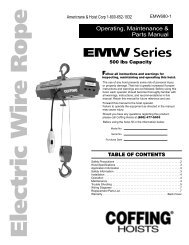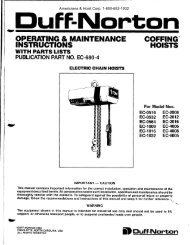ELCMT Series, JLMT 680-1 - Coffing Hoists, Coffing Hoist Parts
ELCMT Series, JLMT 680-1 - Coffing Hoists, Coffing Hoist Parts
ELCMT Series, JLMT 680-1 - Coffing Hoists, Coffing Hoist Parts
- No tags were found...
You also want an ePaper? Increase the reach of your titles
YUMPU automatically turns print PDFs into web optimized ePapers that Google loves.
Country Club RoadP.O. Box 779Wadesboro, NC 28170 USATEL: (800) 477-5003FAX: (800) 374-68533. Before raising a load, always check to see that it is heldsecurely in the saddle of the hook. Never allow a load to beapplied at the tip of the hook. Raise the load only until theload chain is taut and then double check the rigging beforecontinuing to raise the load.4. Stand clear of the load at all times. Before moving the loadalong the runway beam, ensure that all personnel are clearof the runway path and are aware of your intentions.5. With the load suspended, push the “LEFT” or “RIGHT”button to move the load in the desired direction. Avoidletting the load swing excessively while moving the trolley.Always allow the trolley to coast to a stop before reversingits direction. Sudden reversal of the trolley motor causes itto overheat and the load will begin to sway.6. The operator should have a clear view of the load anytimeit is moving and should be sure that the load does notcontact any obstructions. Never leave a suspended loadunattended.7. Do not run the trolley into beam end stops or other trolleyson the beam.8. Never use the hoist and trolley to transport people or tomove loads over people.9. Do not overload the hoist.10. Do not make side pulls with the hoist.11. Do not “sling” the load hook and chain around the load. Usean approved sling.12. Be sure there are no twists in the load chain as it travels intothe hoist housing.This condition should be constantly checkedon double-chained hoists because it is possible for the loadblock to be “capsized” or turned over one or more times.13. Do not operate if direction of hook travel is not the same asindicated on button being pushed.14. Do not operate unless hook travel limit devices function.Test without load each shift.15. Do not operate if chain is not seated properly in sprocketsor sheave grooves.16. Do not operate a damaged or malfunctioning hoist or trolley.Do not use hoist to lift, support or otherwisetransport people.MAINTENANCEINSPECTIONSA planned inspection routine should be established for thishoist based upon frequency of use, severity of use, andenvironmental conditions (Reference ASME Standard B30.16).Some inspections should be made frequently (daily to monthly)and others periodically (monthly to yearly). It is stronglyrecommended that an Inspection and Maintenance Check Listand an Inspector’s Report, similar to those shown in Figures13A and 13B, be used and filed for reference. All inspectionsshould be performed or overseen by a designated inspector.Special inspections should be made following any significantrepairs or any operating occurrence leading one to suspectthat the hoist’s capability may have been impaired.LOWERING WITHOUT POWERIf the power fails with a load suspended, the hoist willautomatically stop. In an emergency the load can be loweredwithout power as follows:1. DISCONNECT HOIST FROM POWER SUPPLY ANDREMOVE ELECTRICAL COVER.Do not allow screw driver blades to touch rotatingfriction disc “C”.Do not allow the load to descend rapidly. This causesthe motor to race and serious damage may result.2. Refer to Figure 7. Open disc brake manually by using twoscrewdriver blades, one on each side of the brake at a pointclose to the brake spring posts. Apply pressure to theunderside of the armature plate (points “X”) to close thesolenoid and release the brake.3. Use several quick releases instead of holding brake opencontinuously. Do not exceed normal lowering speed.HOOKSRefer to Figure 3.1. Inspect the load hook once daily for cracking, extreme wear orspreading. Replace the hook if it is showing any of thesesigns. If the throat opening is spread wider than the maximumpermissible 15% increase listed here, the hook has beenoverstressed and must be replaced. Any hook that is bent ortwisted more than 10 degrees from the plane of an unbenthook must also be replaced. Material wear in the saddle of thehook should not exceed 10% of the original thickness.2. Inspect to see that the hook latch performs the function ofclosing off the hook throat opening in a secure manner whena load is attached. Also, inspect the hook’s threadedconnections for stripping or other damage. The retaining pinshould be intact.3. Load hooks should be inspected for cracks by the magneticparticle, dye penetrant or other suitable crack testinginspection method. This should be done at least once a year.“T” Dimension “X” Dimension*<strong>Hoist</strong> Minimum BottomCapacity Thickness Hook1 Ton & Under 31/32" 1 7 /32"2 Ton 1 5 /32" 1 11 /32"(*) Maximum permissible throat opening of hook.Figure 3 — HookInspection8



